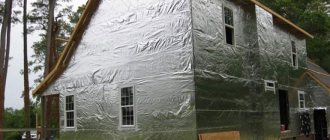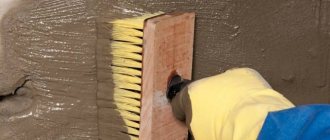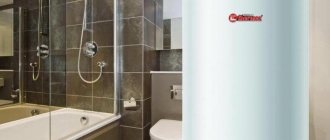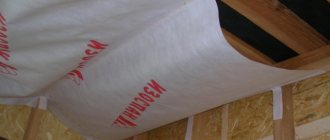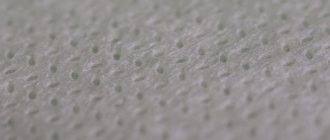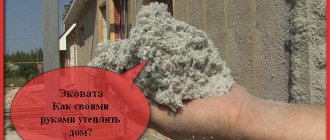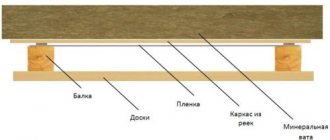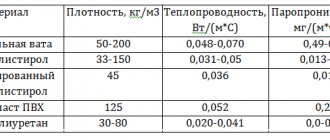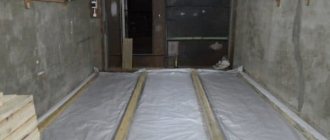Izospan is an insulating film coating. The main purpose of the film is to ensure that the original thermal insulation characteristics are maintained throughout its entire service life. It is difficult to imagine a modern construction project without the use of various types of thermal insulation. Mineral wool, Penoplex, Izolon, Izover, various polystyrene foams and simply polystyrene foam - all these materials require their own protection.
Thermal insulation materials practically envelop our house, retain heat on frosty and rainy days, create comfort in the hot summer, preventing the penetration of heat flows. But how to protect the thermal insulation belt from negative atmospheric phenomena? Reliable protection from moisture, rain, damaging winds is designed to be provided by 100% polypropylene, with the proud name - Izospan .
To create a barrier at the stages of the construction process, to perform the function of protective insulation for thermal insulation, this is the true purpose that isospan vapor barrier successfully fulfills. Despite its apparent simplicity, the material differs by type.
We bring to your attention – Izospan instructions for use. Figure it out: which side to lay the isospan on. Consider the isospan technical characteristics, and the installation method.
Worthy competitors of isospan:
- Tyvek vapor barrier;
- Vapor barrier TechnoNIKOL;
- Vapor barrier Nanoizol;
- Vapor barrier Ondutis;
- Vapor barrier Yutafol.
Before moving on to a detailed review, it should be clarified that the films are presented by the manufacturer in a wide variety and have different purposes. Vapor barrier films and membranes are divided into absolutely vapor- and water-tight and partially permeable to moisture only in one direction. Some of the materials successfully complement thermal insulation, enhancing its characteristics.
Vapor barrier isospan technical characteristics
- The material is waterproof;
- Elasticity is beyond praise; it is not difficult to get around the most difficult areas and bends;
- Resistance to ultraviolet radiation;
- Resistance to negative atmospheric phenomena;
- Does not emit harmful substances. Safe for human health. Does not harm the environment.
- Withstands temperature changes in the range from – 60 °C to + 80 °C
- Fireproof elements added in production determine the fire hazard group G4, which is confirmed by relevant certificates.
Izospan has various applications, taking into account the field of construction use. Isospan, a type of insulation unique in its structure, has individual technical characteristics and its own labeling.
Manufacturers classify their products by letter indices A, B, C, D, F, R. The combination of letter indices adds numerous variety, applications and installation of isospan. Each new designation assumes its own isospan application. This fact must be taken into account when building your home.
roof vapor barrier isospan
Manufacturer company

All categories of Izospan are manufactured by Izospan, which has its own production facility in the Tver region. The company produces various membrane films with vapor barrier, moisture-repellent and energy-saving properties.
Products undergo strict quality control at all stages of production and have international certificates of conformity. Thanks to these features, the products are in consistently high demand in the domestic and European markets.
Izospan A
The membrane, like a check valve, freely allows water vapor to pass through from the thermal insulation side. Does not interfere with the natural ventilation of the insulation. On the other hand, it reliably blocks the penetration of moisture from the external atmosphere, prevents the formation of condensation, and prevents the wind from destroying the structure of the insulation.

Due to the water resistance of the material on the outside, membranes are widely used in roofing structures and are widely used as protection for walls and ventilated facades of buildings and structures for any purpose.
The waterproofing property that the isospan membrane has long extends the service life of the thermal insulation. Even the best insulation is destroyed over time under the influence of wind; the use of Izospan A will be the ideal solution to protect the outside of the house.
In a nutshell, we will clarify which side to lay Izospan A . The question of which side of Izospan A should be laid is far from idle. As we noted, its operation is carried out on the principle of a check valve. Or, if you want: – let everyone out, don’t let anyone through. The membrane must be laid on the outside, on top of the insulation.
The smooth side, which is easily identified by touch, should “look” towards the street. The roll is cut into wide strips of suitable size, after which it is carefully spread over the area, overlapping with the next layer.
Roof vapor barrier
Water vapor barrier of the roof starts from the bottom. When laying isospan A membranes, contact with the thermal insulation material should be avoided. Touching the membrane significantly reduces its waterproofing properties.
Probably those who went camping with their grandfather’s canvas tent noticed that if during rain you run your finger along the “roof” from the inside, then literally after 10 minutes it will drip in that place. It is for this reason that laying Izospan A is allowed only with double lathing.
Isospan flooring is carried out outside the thermal insulation on a lathing made of slats. The use of a membrane increases the degree of insulation and extends the life of the entire structure.
It is extremely important to monitor the absence of possible swelling or sagging during work. Otherwise, you will become a constant listener to gusts of wind with the characteristic sounds of a membrane beating on the roof. Thin slats are enough to secure isospan A, leaving 2-3 centimeters of free space to the insulation.
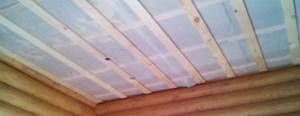
Advantages and disadvantages
The Izospan film of this brand has much more positive features than negative ones.
Benefits stated by the manufacturer:
- resistance to pathogenic microflora;
- environmental Safety;
- immunity to aggressive environments;
- high waterproofing ability;
- resistance to mechanical damage and weather conditions;
- ease of installation;
- The warranty period is 50 years.
The material has only 2 significant drawbacks. The first is the high price of some modifications, the second is flammability.
Izospan B
As we found out, isospan A, firstly, protects from the wind, and secondly, it creates a powerful hydrobarrier for the insulation. There remains a danger in the form of condensation, wetting of the insulation - condensation, which, before passing through the membrane in the form of steam, saturates the thermal insulation with moisture.
Humidification by only 5% will reduce the thermal insulation performance by half. The further prospect is the penetration of condensation onto the metal tiles, with the subsequent transformation of the roof into a colander.
The anti-condensation surface in combination with the steam and waterproof effect will save you from such troubles. When carrying out installation work on arranging the roof, you must clearly understand that even the best insulation for the roof is gradually saturated with water vapor.

By creating a barrier to internal vapors, Izospan B will serve as a kind of vapor barrier. The material consists of two layers, a layer with a smooth structure is adjacent to the insulation during installation, the second fleecy side is designed to absorb condensation.
That is why the installation of the coating is always carried out with the fleecy side down, with a gap to the finishing materials, for ventilation and drying. Type B is laid with an overlap with an overlap of at least 10 centimeters on the insulation side and secured using a construction stapler or another method.
Where is the material used?
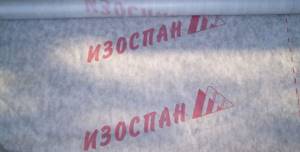
This group “B” (B) is considered universal, therefore it has a rather multifaceted scope of application. The only installation limitation is internal installation. Izospan B is not suitable for external insulation; there are other groups for this. For internal insulation, the material is used to insulate the following surfaces:
- Wall structures.
- Internal partitions.
- Interfloor ceilings.
- Floors in rooms with high humidity.
- Underlay for parquet or laminate.
- Roof insulation.
This demand is due to the fact that the thermal insulation pie will not cope with its functions without a vapor barrier film.
Which side should I lay towards the insulation?

According to the official instructions:
- For the roof. Smooth side to insulation.
- For walls. Smooth side to insulation.
- Attic floors. The film is laid between the finishing material of the living room ceiling and the rough ceiling (smooth side towards the rough ceiling).
- Basement ceiling. The rough side is towards the insulation.
Izospan S
The structure of the material combines two layers: on one side there is a smooth surface, on the other there is a fleecy surface. The fleecy layer retains condensation followed by weathering. Izospan C creates a vapor barrier for the insulation, preventing the absorption of vapor from water particles formed inside the room.
The material is widely used in the construction of walls, installation of insulated, sloping roofs and interfloor ceilings. Steam-waterproofing using type C is installed in various cement screeds and in flat roof structures.
In a word, in structure and characteristics the material is very similar to type B. At the same time, it has an increased margin of safety and, therefore, the reliability of the super-dense panel is higher. Buying isospan C will cost the consumer about 50-60% more than type B.

Characteristics of isospan Type C:
- 100% polypropylene;
- Applicable temperature range -60 – +80 °C;
- Tensile load: longitudinal // transverse. N//5cm not less than 197/119
- Vapor-tight
- water resistance not less than: 1000 mm water column.
Application of isospan S:
- Sloping roof with an overlap of at least 15 cm
- Attic floor protection. A vapor barrier layer is spread on top of the insulation, smooth side down;
- Concrete floor. spread on a concrete surface, smooth side down;
- Wooden floors of horizontal design.
Laying the canvas on sloping roofs should be done from bottom to top. The material overlaps about 15 centimeters.

To avoid depressurization, overlapped joints are glued together with a special tape that is sticky on both sides, similar to double-sided tape.
The structure is secured with slats 5 cm thick. A gap of at least 5 centimeters is left between the roof tiles and the vapor barrier layer; it is necessary for natural ventilation.
Izospan C is spread on top of the insulation; for ventilation it is necessary to leave a gap of about 50 millimeters from the panel to the heat-insulating material. In the installation of a concrete floor, type C, an overlap is laid on the concrete surface, then a cement screed is laid on the canvas, and only after that the floor covering is installed.
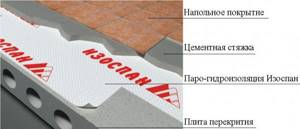
Description, purpose
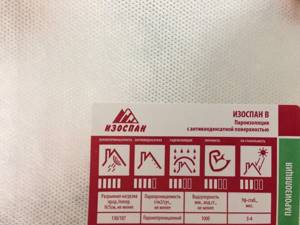
The material Izospan B has high resistance to vapor permeation, water resistance and the necessary strength.
This allows it to be used as:
- vapor barriers to protect insulation and internal structural elements from the penetration of water vapor from inside the room;
- also to protect the internal space of the building from the penetration of particles of fibrous insulation in the structures of insulated pitched roofs, frame walls and ceilings.
If all installation requirements are met, the use of Izospan V vapor barrier allows you to preserve the thermal insulation properties of the insulation and extend the service life of the entire structure.
Areas of use:
- insulated sloping roofs;
- frame walls;
- interior walls;
- attic floors;
- interfloor ceilings;
- basement floors;
Release form:
- width, m — 1.6
- size, m² – 35, 70
Izospan D
High-strength, completely moisture-proof waterproofing material. Polypropylene sheet with one-sided laminated polypropylene coating. The versatility of the moisture-vapor-proof material implies widespread use in construction technologies for the construction of any type of structure.
Izospan D successfully withstands moderately strong mechanical loads, is resistant to tearing, withstands strong gusts of wind, and in winter copes with heavy snow loads. In comparison with other similar films, Izospan D has gained fame as the most durable and reliable option.
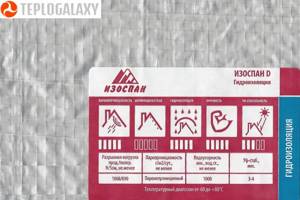
Izospan D Area of application
In any type of roof, as a barrier preventing the formation of under-roof condensation. Widely used in the installation of hydro- and vapor barriers during the construction of buildings and structures. Protection of wooden structures. The material largely resists negative atmospheric phenomena.
Izospan D is often used on construction sites as a temporary roof covering and installation of a protective wall in objects under construction. Such a roof or wall can last up to four months.
Type D is especially popular when constructing concrete floors that require a waterproofing layer to protect against earth moisture.
Why is waterproofing required?
Izospan is used to insulate the roof and protect against moisture accumulating due to the presence of air currents in the room. If you do not take care of protecting the roof, then water gradually accumulates, ultimately leading to the destruction of the insulation system. Because of this, the building becomes cold, and the insulation has to be replaced.
But in order for Izospan to show all its best qualities, it is necessary to prepare for the installation of a protective layer. Before the procedure, you need to make sure that there are no gaps or joints in the insulation. The result is a high-quality layer of an insulation system that does not allow vapors to penetrate from the room and protects the roof from precipitation.
Main types of products
Izospan is quite demanding about the materials it produces, so each roll leaves the machine only when it meets the established standards and technical parameters.
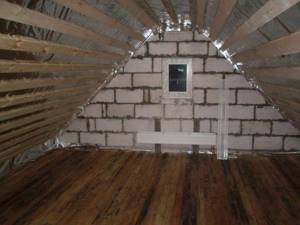
An example of roof insulation with isospan
Among the main types of products, the following should be highlighted:
- Izospan A. Is a protective membrane that prevents the harmful effects of the environment on the insulation layer. Used exclusively for interior work. The material is vapor permeable (3500 g/m2), so it removes excess moisture outside. Most often used when installing roofs.
- Izospan A.M. and A.S. It is mounted directly on the insulation layer, which means a reduction in additional costs for the construction of the sheathing. In addition to a high level of vapor permeability (1550 g/m2) and thermal conductivity coefficient, this material has such an indicator as good water resistance.
- Izospan AQ proff. In addition to vapor permeability and water resistance, the AQ proff film also received such a characteristic as a high degree of breaking load. This means that the product has good strength and can be used under conditions of constant mechanical stress.
- Izospan B and C. Prevents the effects of moisture on the internal (located inside the room) surface of the insulation. Due to the rough structure on one side of the sheet, Izospan S retains excess condensate efficiently and for a long time.
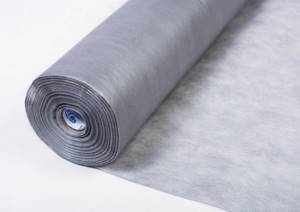
Izospan B – high-quality and durable material
*
- Izospan D. A unique roofing material that can reliably protect a house from the harmful effects of the environment. The shelf life under such conditions is no more than 4 months. An additional layer is applied to the surface of the film to prevent the appearance of condensation. It is used for both external and internal work.
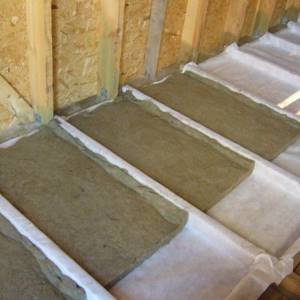
The entire list of products can be seen on the company’s official price list. Izospan (which has a variety of uses) also specializes in materials with a stronger structure, such as reinforced frame waterproofing.

